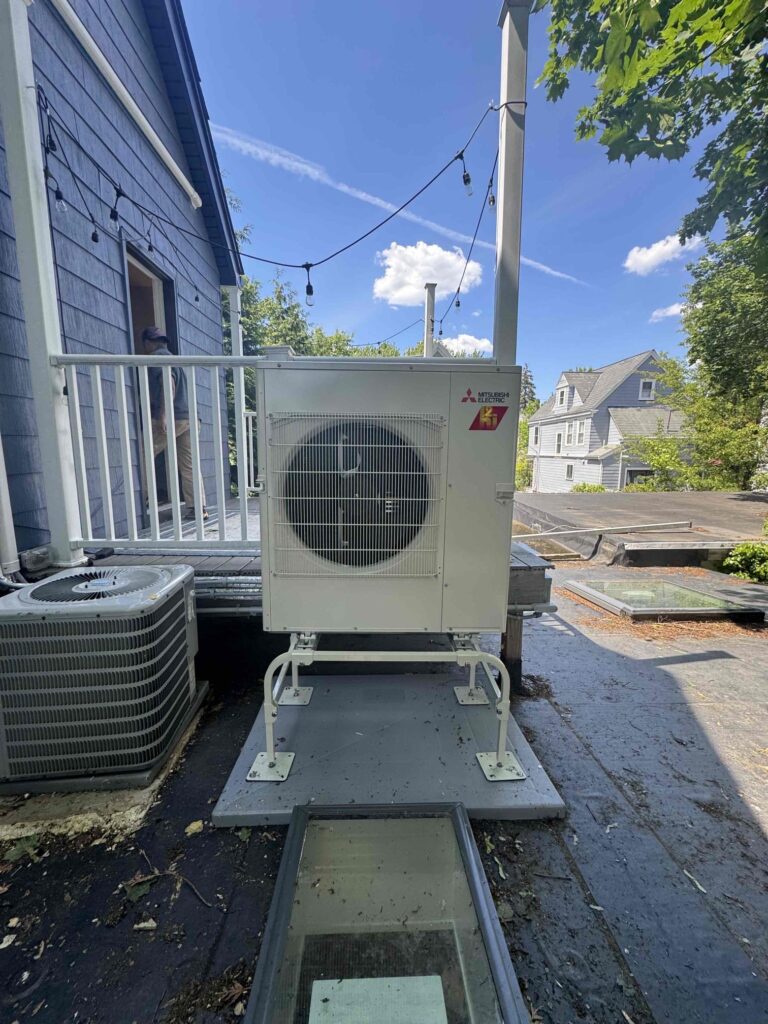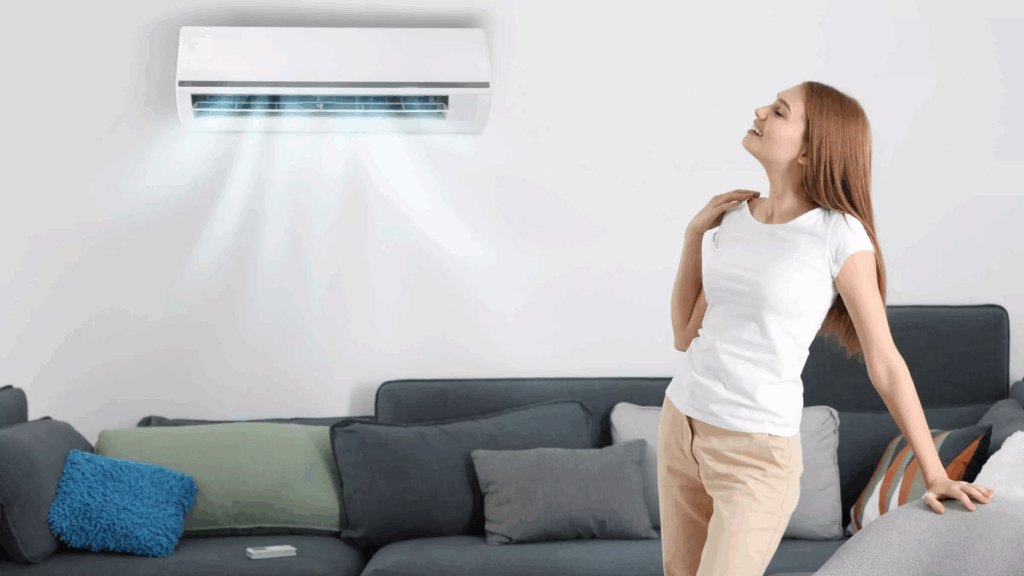Deciding between a central AC and a ductless cooling system can be tough. Factors like home layout, budget, and local climate add complexity to the decision-making process. But don’t be overwhelmed by the details. You can use this guide to explore the pros and cons of each system and make an informed choice that suits your needs and preferences.
Understanding Central AC Systems
Central AC systems operate by using an indoor and an outdoor unit to cool an entire building. The system circulates cool air through a network of ducts to various rooms. It consists of a compressor, a condenser coil, an evaporator coil, a blower fan, and refrigerant. As indoor air flows over the evaporator coil, refrigerant absorbs heat and releases it to the outside condenser coil. The blower fan then distributes the cooled air through ducts and vents into the home, lowering indoor temperatures.
Pros of central AC systems include efficient cooling of large spaces, consistent temperature control throughout the home, and the ability to filter indoor air. However, these systems need ductwork to function correctly, which can be expensive to install in older homes or those without existing duct systems. Because of this, these systems often have higher up-front costs compared to ductless systems.
Ideal home types for central AC systems include larger homes with existing ductwork. They also work well in multi-story residences. Central AC is suitable for homes located in regions with hot climates where powerful cooling is essential for comfort.
Installation costs for central AC systems vary depending on factors such as home size and ductwork complexity. Maintenance costs typically include filter replacements, annual inspections, and occasional repairs. System efficiency, house insulation, and thermostat settings are some of the variables that impact energy usage expenses.
Exploring Ductless Cooling Systems
Ductless cooling systems, also known as mini-split systems, operate without the need for ductwork to distribute cooled air throughout a home. Refrigerant lines and electrical wires link an outdoor condenser unit to one or more inside air handling units. Individually controlled indoor units allow for customizable temperature settings and energy efficiency.
Without the need for ductwork, ductless systems are easier and less invasive to install. This makes them ideal for older homes or buildings where adding ducts may be impractical or costly. Ductless systems also offer zoning capabilities, allowing homeowners to cool specific areas of the home based on occupancy and preference.
Another advantage of ductless systems is their energy efficiency. By eliminating ductwork and allowing for individualized temperature control, ductless systems can reduce the energy waste associated with central AC systems. Plus, ductless systems typically have higher SEER ratings compared to central AC units, further enhancing their energy efficiency.
However, ductless systems also have some disadvantages to consider. While they offer flexibility in installation, ductless systems may have higher up-front costs compared to central AC systems. This is especially true when a home needs multiple indoor units. It’s also worth noting that indoor units can be visually intrusive, requiring wall-mounted or ceiling-mounted installation, which may not be aesthetically pleasing for some homeowners.
Ductless cooling systems are ideal for older houses without ductwork, smaller homes or flats with limited space, and residences with room-specific cooling demands. They are also suitable for home additions, workshops, garages, and other spaces where centralized cooling may not be practical or cost-effective. Maintenance costs usually include periodic filter replacements and occasional inspections by HVAC professionals to ensure optimal performance and efficiency.
How Your Selection Affects the Resale Value of Your Home
Central AC systems are more common and may appeal to buyers looking for traditional cooling solutions. However, ductless systems offer advantages such as energy efficiency and zoning capabilities, which may attract eco-conscious buyers or those seeking personalized comfort. Consider your target market and regional trends when making your decision. While a central AC system might appeal to a broader audience, a ductless system could add value for buyers seeking modern, energy-efficient features. Ultimately, investing in the right cooling system for your needs can enhance your home’s appeal and potentially increase its resale value.
What Type of System Is Quieter?
When comparing the noise levels of central AC and ductless systems, it depends on various factors such as the model, installation quality, and maintenance. Generally, ductless systems tend to be quieter than central AC units because they have smaller indoor units and operate with less powerful fans. Some versions also come with sound-dampening features and variable-speed compressors that help minimize noise levels during operation. However, both systems can produce some level of noise, so it’s essential to consider factors like location and insulation when determining overall sound levels.
Which System Provides the Best Energy-Efficiency?
Determining the most energy-efficient system between central AC and ductless HVAC depends on various factors, including the specific models, installation quality, and usage patterns. Generally, ductless HVAC systems tend to be more energy-efficient than central AC systems due to their zoning capabilities and lack of ductwork, which minimizes energy losses. However, selecting the most energy-efficient system for your home requires considering factors like climate, home size, and insulation levels.
Do These Systems Work With Smart Technologies?
Both central AC and ductless HVAC systems can work with smart technologies. You can hook them up with smart thermostats, letting you tweak the temperature from anywhere using your phone or just your voice if you’re nearby. These smart thermostats offer awesome features like scheduling and energy tracking, helping you stay comfy while saving energy. Plus, lots of HVAC brands offer smart integration options that let you keep an eye on your system’s performance and get maintenance alerts.
Do Some Homes Benefit From Both Central AC and Ductless Cooling?
Some homes can benefit from a combination of both central AC and ductless cooling systems, depending on their specific needs and layout. This hybrid approach allows homeowners to maximize comfort and energy efficiency throughout different areas of their home. For example, a home with an existing central AC may choose to supplement it with a ductless mini-split system in areas where cooling is inadequate or the area is difficult to reach, such as new room additions, sunrooms, or upper floors.
How the Professionals Can Help
When you’re trying to choose between a central AC and a ductless system, professional HVAC technicians are your go-to experts. They have the know-how to assess your home’s layout and cooling needs in order to give you the best advice. They’ll dig into details like energy efficiency, installation, and budget considerations to find the perfect cooling solution. Plus, they’ll suggest the right size, placement, and maintenance tips to keep your system running like a dream for years to come. So, if you’re feeling a bit out of your depth, don’t stress. Just reach out to your friendly neighborhood HVAC professional and let them take the reins.
[company_name] is here to help you choose the best system for your home. We also help homeowners with furnace and heat pump selections as well as a complete line of HVAC repairs and maintenance. Give us a call today to speak with an expert about your home’s cooling needs.





